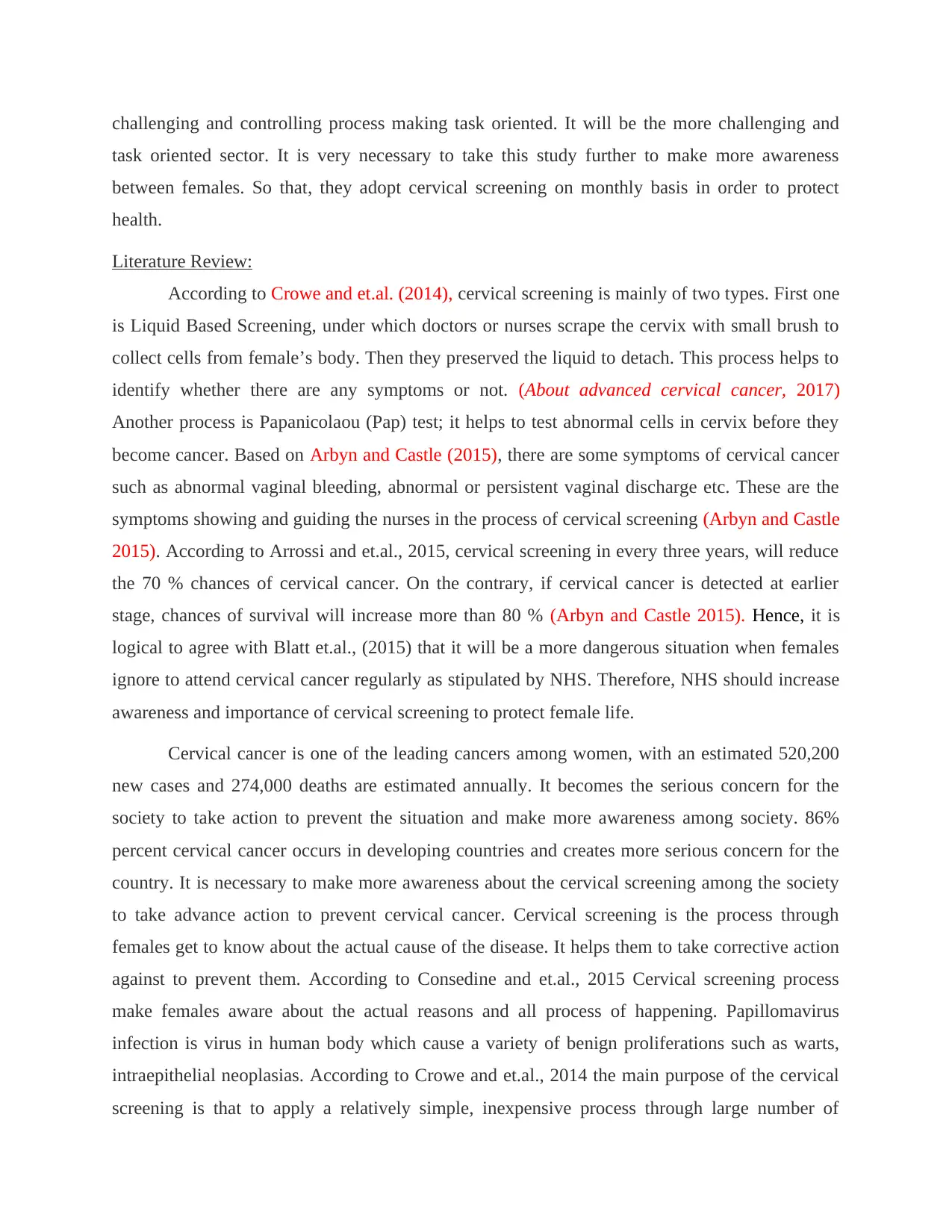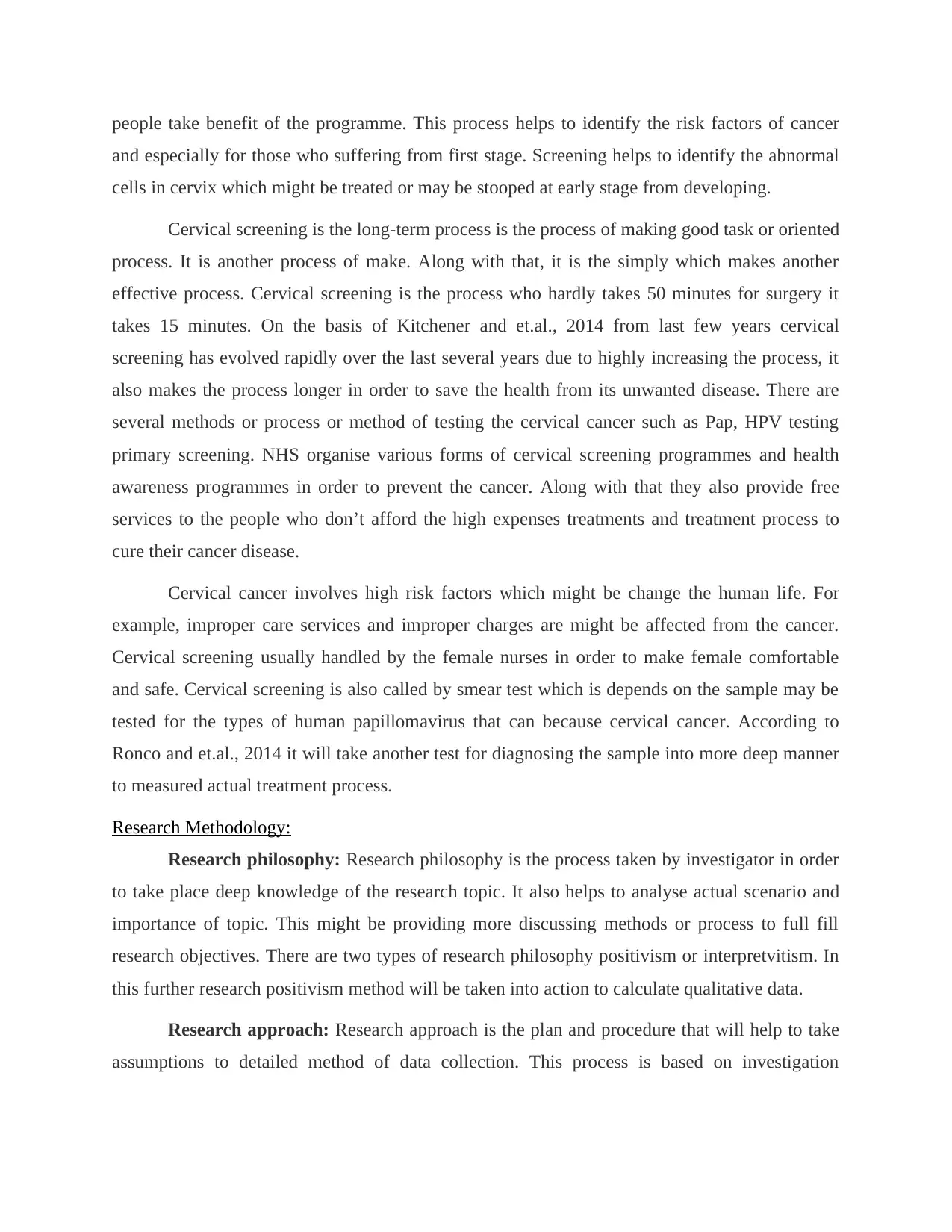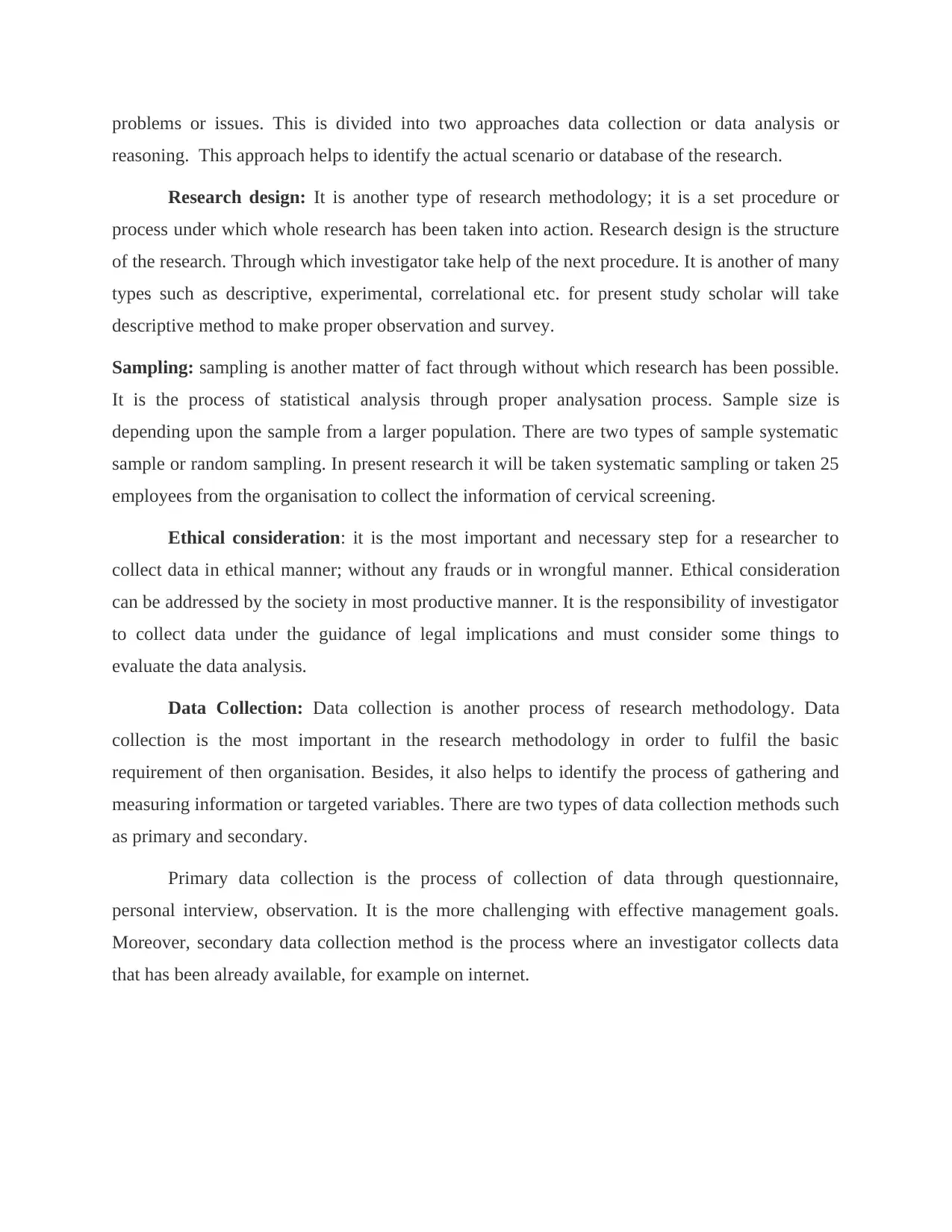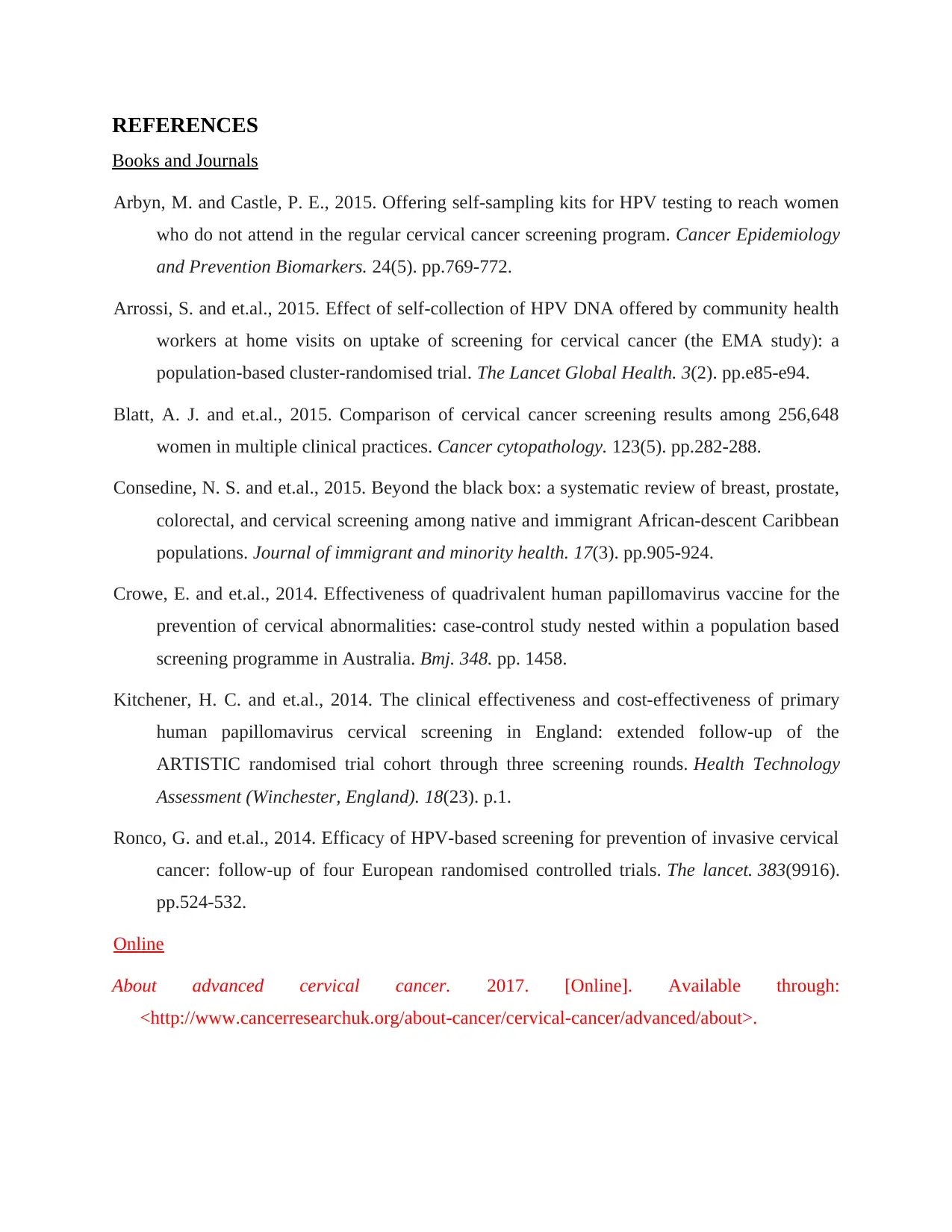Research Proposal: Impact of Cervical Screening on Women's Health
VerifiedAdded on 2020/07/23
|6
|2049
|110
Project
AI Summary
This research proposal investigates the impacts and importance of cervical screening for female health. It explores the process of cervical cancer development, emphasizing the significance of early detection through screening methods like Liquid Based Screening and Pap tests. The proposal reviews existing literature, including studies on screening frequency and the role of the NHS in promoting awareness. It outlines the research methodology, detailing the research philosophy (positivism), approach, design (descriptive), sampling (systematic), ethical considerations, and data collection methods (primary and secondary). The study aims to analyze the current health care practices and create awareness among women to adopt cervical screening on a regular basis to protect their health and prevent cervical cancer. The proposal references key studies on the effectiveness of cervical screening and the impact of HPV. The research seeks to contribute to the understanding of cervical cancer prevention and improve women's health outcomes.

Research
Proposal
By Sagal Garane
Proposal
By Sagal Garane
Paraphrase This Document
Need a fresh take? Get an instant paraphrase of this document with our AI Paraphraser

INTRODUCTION
Background
Cervical is an adjective from the word cervix which is the lower portion of the uterus that
connects the uterus to the vagina. Besides, cervical cancer occurs when the cells in cervix grow
erratically and multiply out of control. In contrary to other cancers, cervical cancer takes years to
develop by going through certain process involving cervical cells change from normal cells into
pre-cancerous cells and finally change to cancerous cells. Clinically, pre-cancerous stage of
cervical cancers is very evasive to diagnose because this stage does not present with any
symptoms and signs. Without screening, the pre-cancerous stage progresses to cancer. The
crucial aspect of this stage is that, a good screening would detect this stage and prevents further
growth of this cancer Overall, cervical screening is the process by which females can check their
health issues in relation to the status of their statuses and early treatment could follow suit.
Questions:
What are the impacts of cervical screening on Female Genders?
What is the importance of cervical screening?
What are the precautions should take to prevent cervical cancer?
Research
This is the fact that cervical cancer often shows any kind of symptoms in its early stages.
In order to identify the symptoms, there is a need of cervical screening, through human being can
get to know about their health issues and take early process of treatment. Research will be taking
place many aspects of importance of cervical screening. It also explains the different types of
cervical screening test which is more important for the female genders.
Research Outline
Cervical screening test is the method of detecting abnormal cells on the cervix; the cervix
is entrance to womb from the vagina. Detecting and removing abnormal cells can prevent
cervical cancer. Health care organisation plays the biggest role to take care the health issues of
the people. They found the best techniques and treatments for cause removing process or make
better and healthy environment in society. Present study is based on cervical test. it is the major
health issues which is commonly found in the females. Further, research is based on health care
sector. For that, NHS non-profit organisations will be taken into action. It will be more
Background
Cervical is an adjective from the word cervix which is the lower portion of the uterus that
connects the uterus to the vagina. Besides, cervical cancer occurs when the cells in cervix grow
erratically and multiply out of control. In contrary to other cancers, cervical cancer takes years to
develop by going through certain process involving cervical cells change from normal cells into
pre-cancerous cells and finally change to cancerous cells. Clinically, pre-cancerous stage of
cervical cancers is very evasive to diagnose because this stage does not present with any
symptoms and signs. Without screening, the pre-cancerous stage progresses to cancer. The
crucial aspect of this stage is that, a good screening would detect this stage and prevents further
growth of this cancer Overall, cervical screening is the process by which females can check their
health issues in relation to the status of their statuses and early treatment could follow suit.
Questions:
What are the impacts of cervical screening on Female Genders?
What is the importance of cervical screening?
What are the precautions should take to prevent cervical cancer?
Research
This is the fact that cervical cancer often shows any kind of symptoms in its early stages.
In order to identify the symptoms, there is a need of cervical screening, through human being can
get to know about their health issues and take early process of treatment. Research will be taking
place many aspects of importance of cervical screening. It also explains the different types of
cervical screening test which is more important for the female genders.
Research Outline
Cervical screening test is the method of detecting abnormal cells on the cervix; the cervix
is entrance to womb from the vagina. Detecting and removing abnormal cells can prevent
cervical cancer. Health care organisation plays the biggest role to take care the health issues of
the people. They found the best techniques and treatments for cause removing process or make
better and healthy environment in society. Present study is based on cervical test. it is the major
health issues which is commonly found in the females. Further, research is based on health care
sector. For that, NHS non-profit organisations will be taken into action. It will be more

challenging and controlling process making task oriented. It will be the more challenging and
task oriented sector. It is very necessary to take this study further to make more awareness
between females. So that, they adopt cervical screening on monthly basis in order to protect
health.
Literature Review:
According to Crowe and et.al. (2014), cervical screening is mainly of two types. First one
is Liquid Based Screening, under which doctors or nurses scrape the cervix with small brush to
collect cells from female’s body. Then they preserved the liquid to detach. This process helps to
identify whether there are any symptoms or not. (About advanced cervical cancer, 2017)
Another process is Papanicolaou (Pap) test; it helps to test abnormal cells in cervix before they
become cancer. Based on Arbyn and Castle (2015), there are some symptoms of cervical cancer
such as abnormal vaginal bleeding, abnormal or persistent vaginal discharge etc. These are the
symptoms showing and guiding the nurses in the process of cervical screening (Arbyn and Castle
2015). According to Arrossi and et.al., 2015, cervical screening in every three years, will reduce
the 70 % chances of cervical cancer. On the contrary, if cervical cancer is detected at earlier
stage, chances of survival will increase more than 80 % (Arbyn and Castle 2015). Hence, it is
logical to agree with Blatt et.al., (2015) that it will be a more dangerous situation when females
ignore to attend cervical cancer regularly as stipulated by NHS. Therefore, NHS should increase
awareness and importance of cervical screening to protect female life.
Cervical cancer is one of the leading cancers among women, with an estimated 520,200
new cases and 274,000 deaths are estimated annually. It becomes the serious concern for the
society to take action to prevent the situation and make more awareness among society. 86%
percent cervical cancer occurs in developing countries and creates more serious concern for the
country. It is necessary to make more awareness about the cervical screening among the society
to take advance action to prevent cervical cancer. Cervical screening is the process through
females get to know about the actual cause of the disease. It helps them to take corrective action
against to prevent them. According to Consedine and et.al., 2015 Cervical screening process
make females aware about the actual reasons and all process of happening. Papillomavirus
infection is virus in human body which cause a variety of benign proliferations such as warts,
intraepithelial neoplasias. According to Crowe and et.al., 2014 the main purpose of the cervical
screening is that to apply a relatively simple, inexpensive process through large number of
task oriented sector. It is very necessary to take this study further to make more awareness
between females. So that, they adopt cervical screening on monthly basis in order to protect
health.
Literature Review:
According to Crowe and et.al. (2014), cervical screening is mainly of two types. First one
is Liquid Based Screening, under which doctors or nurses scrape the cervix with small brush to
collect cells from female’s body. Then they preserved the liquid to detach. This process helps to
identify whether there are any symptoms or not. (About advanced cervical cancer, 2017)
Another process is Papanicolaou (Pap) test; it helps to test abnormal cells in cervix before they
become cancer. Based on Arbyn and Castle (2015), there are some symptoms of cervical cancer
such as abnormal vaginal bleeding, abnormal or persistent vaginal discharge etc. These are the
symptoms showing and guiding the nurses in the process of cervical screening (Arbyn and Castle
2015). According to Arrossi and et.al., 2015, cervical screening in every three years, will reduce
the 70 % chances of cervical cancer. On the contrary, if cervical cancer is detected at earlier
stage, chances of survival will increase more than 80 % (Arbyn and Castle 2015). Hence, it is
logical to agree with Blatt et.al., (2015) that it will be a more dangerous situation when females
ignore to attend cervical cancer regularly as stipulated by NHS. Therefore, NHS should increase
awareness and importance of cervical screening to protect female life.
Cervical cancer is one of the leading cancers among women, with an estimated 520,200
new cases and 274,000 deaths are estimated annually. It becomes the serious concern for the
society to take action to prevent the situation and make more awareness among society. 86%
percent cervical cancer occurs in developing countries and creates more serious concern for the
country. It is necessary to make more awareness about the cervical screening among the society
to take advance action to prevent cervical cancer. Cervical screening is the process through
females get to know about the actual cause of the disease. It helps them to take corrective action
against to prevent them. According to Consedine and et.al., 2015 Cervical screening process
make females aware about the actual reasons and all process of happening. Papillomavirus
infection is virus in human body which cause a variety of benign proliferations such as warts,
intraepithelial neoplasias. According to Crowe and et.al., 2014 the main purpose of the cervical
screening is that to apply a relatively simple, inexpensive process through large number of
⊘ This is a preview!⊘
Do you want full access?
Subscribe today to unlock all pages.

Trusted by 1+ million students worldwide

people take benefit of the programme. This process helps to identify the risk factors of cancer
and especially for those who suffering from first stage. Screening helps to identify the abnormal
cells in cervix which might be treated or may be stooped at early stage from developing.
Cervical screening is the long-term process is the process of making good task or oriented
process. It is another process of make. Along with that, it is the simply which makes another
effective process. Cervical screening is the process who hardly takes 50 minutes for surgery it
takes 15 minutes. On the basis of Kitchener and et.al., 2014 from last few years cervical
screening has evolved rapidly over the last several years due to highly increasing the process, it
also makes the process longer in order to save the health from its unwanted disease. There are
several methods or process or method of testing the cervical cancer such as Pap, HPV testing
primary screening. NHS organise various forms of cervical screening programmes and health
awareness programmes in order to prevent the cancer. Along with that they also provide free
services to the people who don’t afford the high expenses treatments and treatment process to
cure their cancer disease.
Cervical cancer involves high risk factors which might be change the human life. For
example, improper care services and improper charges are might be affected from the cancer.
Cervical screening usually handled by the female nurses in order to make female comfortable
and safe. Cervical screening is also called by smear test which is depends on the sample may be
tested for the types of human papillomavirus that can because cervical cancer. According to
Ronco and et.al., 2014 it will take another test for diagnosing the sample into more deep manner
to measured actual treatment process.
Research Methodology:
Research philosophy: Research philosophy is the process taken by investigator in order
to take place deep knowledge of the research topic. It also helps to analyse actual scenario and
importance of topic. This might be providing more discussing methods or process to full fill
research objectives. There are two types of research philosophy positivism or interpretvitism. In
this further research positivism method will be taken into action to calculate qualitative data.
Research approach: Research approach is the plan and procedure that will help to take
assumptions to detailed method of data collection. This process is based on investigation
and especially for those who suffering from first stage. Screening helps to identify the abnormal
cells in cervix which might be treated or may be stooped at early stage from developing.
Cervical screening is the long-term process is the process of making good task or oriented
process. It is another process of make. Along with that, it is the simply which makes another
effective process. Cervical screening is the process who hardly takes 50 minutes for surgery it
takes 15 minutes. On the basis of Kitchener and et.al., 2014 from last few years cervical
screening has evolved rapidly over the last several years due to highly increasing the process, it
also makes the process longer in order to save the health from its unwanted disease. There are
several methods or process or method of testing the cervical cancer such as Pap, HPV testing
primary screening. NHS organise various forms of cervical screening programmes and health
awareness programmes in order to prevent the cancer. Along with that they also provide free
services to the people who don’t afford the high expenses treatments and treatment process to
cure their cancer disease.
Cervical cancer involves high risk factors which might be change the human life. For
example, improper care services and improper charges are might be affected from the cancer.
Cervical screening usually handled by the female nurses in order to make female comfortable
and safe. Cervical screening is also called by smear test which is depends on the sample may be
tested for the types of human papillomavirus that can because cervical cancer. According to
Ronco and et.al., 2014 it will take another test for diagnosing the sample into more deep manner
to measured actual treatment process.
Research Methodology:
Research philosophy: Research philosophy is the process taken by investigator in order
to take place deep knowledge of the research topic. It also helps to analyse actual scenario and
importance of topic. This might be providing more discussing methods or process to full fill
research objectives. There are two types of research philosophy positivism or interpretvitism. In
this further research positivism method will be taken into action to calculate qualitative data.
Research approach: Research approach is the plan and procedure that will help to take
assumptions to detailed method of data collection. This process is based on investigation
Paraphrase This Document
Need a fresh take? Get an instant paraphrase of this document with our AI Paraphraser

problems or issues. This is divided into two approaches data collection or data analysis or
reasoning. This approach helps to identify the actual scenario or database of the research.
Research design: It is another type of research methodology; it is a set procedure or
process under which whole research has been taken into action. Research design is the structure
of the research. Through which investigator take help of the next procedure. It is another of many
types such as descriptive, experimental, correlational etc. for present study scholar will take
descriptive method to make proper observation and survey.
Sampling: sampling is another matter of fact through without which research has been possible.
It is the process of statistical analysis through proper analysation process. Sample size is
depending upon the sample from a larger population. There are two types of sample systematic
sample or random sampling. In present research it will be taken systematic sampling or taken 25
employees from the organisation to collect the information of cervical screening.
Ethical consideration: it is the most important and necessary step for a researcher to
collect data in ethical manner; without any frauds or in wrongful manner. Ethical consideration
can be addressed by the society in most productive manner. It is the responsibility of investigator
to collect data under the guidance of legal implications and must consider some things to
evaluate the data analysis.
Data Collection: Data collection is another process of research methodology. Data
collection is the most important in the research methodology in order to fulfil the basic
requirement of then organisation. Besides, it also helps to identify the process of gathering and
measuring information or targeted variables. There are two types of data collection methods such
as primary and secondary.
Primary data collection is the process of collection of data through questionnaire,
personal interview, observation. It is the more challenging with effective management goals.
Moreover, secondary data collection method is the process where an investigator collects data
that has been already available, for example on internet.
reasoning. This approach helps to identify the actual scenario or database of the research.
Research design: It is another type of research methodology; it is a set procedure or
process under which whole research has been taken into action. Research design is the structure
of the research. Through which investigator take help of the next procedure. It is another of many
types such as descriptive, experimental, correlational etc. for present study scholar will take
descriptive method to make proper observation and survey.
Sampling: sampling is another matter of fact through without which research has been possible.
It is the process of statistical analysis through proper analysation process. Sample size is
depending upon the sample from a larger population. There are two types of sample systematic
sample or random sampling. In present research it will be taken systematic sampling or taken 25
employees from the organisation to collect the information of cervical screening.
Ethical consideration: it is the most important and necessary step for a researcher to
collect data in ethical manner; without any frauds or in wrongful manner. Ethical consideration
can be addressed by the society in most productive manner. It is the responsibility of investigator
to collect data under the guidance of legal implications and must consider some things to
evaluate the data analysis.
Data Collection: Data collection is another process of research methodology. Data
collection is the most important in the research methodology in order to fulfil the basic
requirement of then organisation. Besides, it also helps to identify the process of gathering and
measuring information or targeted variables. There are two types of data collection methods such
as primary and secondary.
Primary data collection is the process of collection of data through questionnaire,
personal interview, observation. It is the more challenging with effective management goals.
Moreover, secondary data collection method is the process where an investigator collects data
that has been already available, for example on internet.

REFERENCES
Books and Journals
Arbyn, M. and Castle, P. E., 2015. Offering self-sampling kits for HPV testing to reach women
who do not attend in the regular cervical cancer screening program. Cancer Epidemiology
and Prevention Biomarkers. 24(5). pp.769-772.
Arrossi, S. and et.al., 2015. Effect of self-collection of HPV DNA offered by community health
workers at home visits on uptake of screening for cervical cancer (the EMA study): a
population-based cluster-randomised trial. The Lancet Global Health. 3(2). pp.e85-e94.
Blatt, A. J. and et.al., 2015. Comparison of cervical cancer screening results among 256,648
women in multiple clinical practices. Cancer cytopathology. 123(5). pp.282-288.
Consedine, N. S. and et.al., 2015. Beyond the black box: a systematic review of breast, prostate,
colorectal, and cervical screening among native and immigrant African-descent Caribbean
populations. Journal of immigrant and minority health. 17(3). pp.905-924.
Crowe, E. and et.al., 2014. Effectiveness of quadrivalent human papillomavirus vaccine for the
prevention of cervical abnormalities: case-control study nested within a population based
screening programme in Australia. Bmj. 348. pp. 1458.
Kitchener, H. C. and et.al., 2014. The clinical effectiveness and cost-effectiveness of primary
human papillomavirus cervical screening in England: extended follow-up of the
ARTISTIC randomised trial cohort through three screening rounds. Health Technology
Assessment (Winchester, England). 18(23). p.1.
Ronco, G. and et.al., 2014. Efficacy of HPV-based screening for prevention of invasive cervical
cancer: follow-up of four European randomised controlled trials. The lancet. 383(9916).
pp.524-532.
Online
About advanced cervical cancer. 2017. [Online]. Available through:
<http://www.cancerresearchuk.org/about-cancer/cervical-cancer/advanced/about>.
Books and Journals
Arbyn, M. and Castle, P. E., 2015. Offering self-sampling kits for HPV testing to reach women
who do not attend in the regular cervical cancer screening program. Cancer Epidemiology
and Prevention Biomarkers. 24(5). pp.769-772.
Arrossi, S. and et.al., 2015. Effect of self-collection of HPV DNA offered by community health
workers at home visits on uptake of screening for cervical cancer (the EMA study): a
population-based cluster-randomised trial. The Lancet Global Health. 3(2). pp.e85-e94.
Blatt, A. J. and et.al., 2015. Comparison of cervical cancer screening results among 256,648
women in multiple clinical practices. Cancer cytopathology. 123(5). pp.282-288.
Consedine, N. S. and et.al., 2015. Beyond the black box: a systematic review of breast, prostate,
colorectal, and cervical screening among native and immigrant African-descent Caribbean
populations. Journal of immigrant and minority health. 17(3). pp.905-924.
Crowe, E. and et.al., 2014. Effectiveness of quadrivalent human papillomavirus vaccine for the
prevention of cervical abnormalities: case-control study nested within a population based
screening programme in Australia. Bmj. 348. pp. 1458.
Kitchener, H. C. and et.al., 2014. The clinical effectiveness and cost-effectiveness of primary
human papillomavirus cervical screening in England: extended follow-up of the
ARTISTIC randomised trial cohort through three screening rounds. Health Technology
Assessment (Winchester, England). 18(23). p.1.
Ronco, G. and et.al., 2014. Efficacy of HPV-based screening for prevention of invasive cervical
cancer: follow-up of four European randomised controlled trials. The lancet. 383(9916).
pp.524-532.
Online
About advanced cervical cancer. 2017. [Online]. Available through:
<http://www.cancerresearchuk.org/about-cancer/cervical-cancer/advanced/about>.
⊘ This is a preview!⊘
Do you want full access?
Subscribe today to unlock all pages.

Trusted by 1+ million students worldwide
1 out of 6
Related Documents
Your All-in-One AI-Powered Toolkit for Academic Success.
+13062052269
info@desklib.com
Available 24*7 on WhatsApp / Email
![[object Object]](/_next/static/media/star-bottom.7253800d.svg)
Unlock your academic potential
Copyright © 2020–2025 A2Z Services. All Rights Reserved. Developed and managed by ZUCOL.




